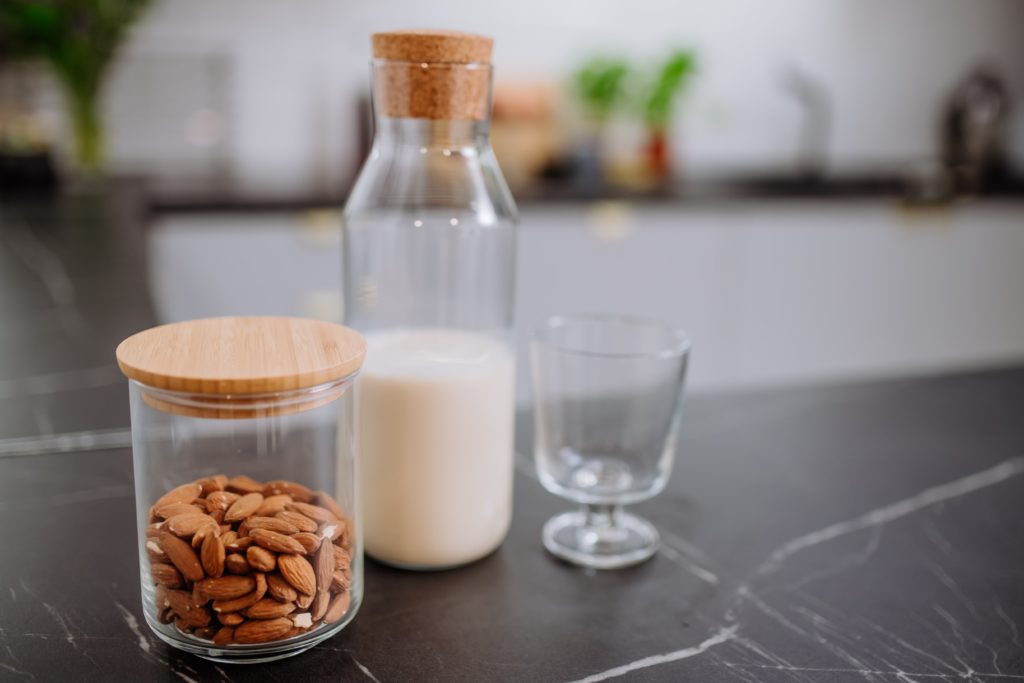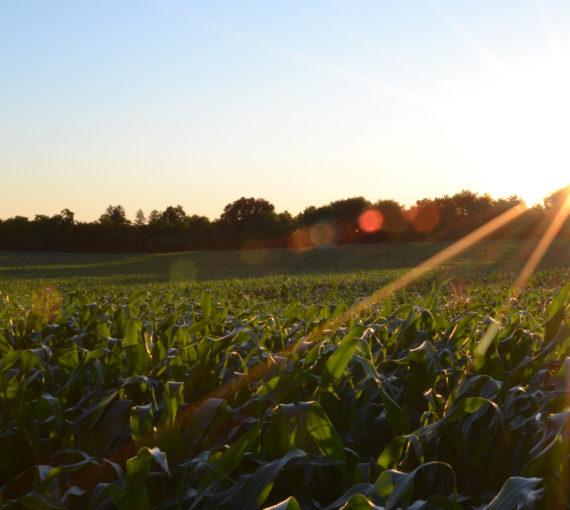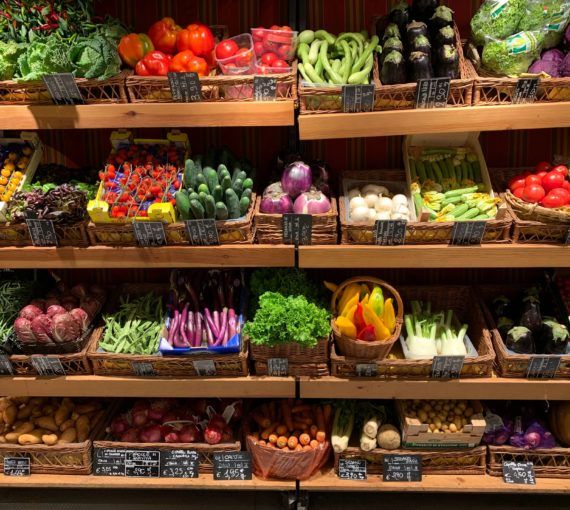
Made from ground almonds and water, almond milk goes back to medieval Europe and the Middle East.
People who are lactose intolerant and/or who favour plant-based diets have long used plant-based milks as an alternative to dairy. But more folks are buying it for environmental reasons.
Once coffee shops and stores didn’t stock non-dairy milks. Now, with the popularity of soy, oat, almond, cashew and coconut milks, most places have many options!
You decide which plant-based milk is best for you. Here’s help to determine which ones are best for the planet.
Moo-ve over dairy milk
Dairy milk is the worst choice for the environment:
- Cows are notorious for releasing methane, a potent greenhouse gas responsible for one-quarter of global warming emissions.
- Poor handling of manure and fertilizers can degrade local water resources.
- Feed production and farming can lead to the loss of important biodiverse areas such as prairies, wetlands and forests.
- Dairy farming also requires a significant amount of land, water and other resources.
But not everyone has access or can choose non-dairy milk alternatives. If you’re opting for dairy milk, try to buy from local and organic farmers.
History of plant milk
So… if it’s not coming from a mammal that suckles its young, why do we call it plant-based “milk”?
The plant-based “milk” (or “mylk”) name signifies a similar function to dairy milk. These beverages are often used as substitutes in recipes and to add to coffee or tea. It’s also a marketing strategy to make plant-based beverages more appealing to consumers seeking dairy-free alternatives.
Many cultures and cuisines have used plant milks for millennia. Most weren’t called “milk” until the 20th century. The first one documented dates back to 1365 in China, where soy milk (doujiang) appeared in written text (and was likely around for far longer).
“Milk” has described more than creamy beverages. In the British Columbia interior, Nlaka’pamux elders call a sugar made of Douglas fir branches sqəqeʔm-éłq, which means “tree breast milk.”
Determining which plant-based milk is best for the environment depends on your focus: water, greenhouse gas emissions or land use.
Soy milk
Soy milk, made from soaked and ground soybeans, is the “original alternative milk.” Its history dates back to the 12th century.
It became a staple in traditional Chinese cooking by the 17th century. When upon arrival in North America, several journals mentioned it, including one with a table comparing its nutritional qualities to cow’s milk.
Large-scale soy milk production began in North America in the early 20th century in response to growing lactose intolerance.
Environmental impact of soy milk
Soy, one of the most widely grown crops in the world, uses less water and land than what’s used for dairy milk. But a study published in Food Climate Research Network by Oxford University in 2020 shows soy production as a leading contributor to Amazon rainforest deforestation.
Brazil is among the top three global producers of soy. Farmers once cultivated soy as livestock feed, but this has shifted to accommodate rising consumer demand for soy milk. This has resulted in more Amazon land deforestation to expand farms or create new ones.
Oat milk
In the early 1990s, Swedish food scientist Rickard Öste experimented with making a nutritious, sustainable non-dairy milk. He landed on the idea of using oats, a common and inexpensive crop in Sweden.
Oat milk is made by soaking oats in water and straining the mixture into a creamy liquid. Öste founded Oatly in 1994. It began exporting products worldwide in the early 2010s.
Oat milk is now one of the most popular non-dairy milk alternatives in North America.
Environmental impact of oat milk
Oat milk uses 60 per cent less energy, 80 per cent fewer carbon emissions and 80 per cent less land than cow’s milk, according to a 2021 study.
Oats use the least amount of water when compared to other plants. An Oxford University study concluded that a glass of oat milk requires 80 per cent less water than a glass of dairy milk.
Oat milk production still requires land and energy, including for growing, transportation and processing. Commercial growing processes may also use pesticides and fertilizers, which have negative impacts on land, water and ecosystems.
Almond milk
Made from ground almonds and water, almond milk goes back to medieval Europe and the Middle East.
Almond trees are native to the Middle East. They were one of the earliest trees humans domesticated. Soon after, people brought them across the Mediterranean to southern Europe, northern Africa and east to India.
Almond milk was not part of ancient Middle Eastern cuisine. Medieval Europeans included it in almost all their cookbooks. It continues to rank as the most consumed plant milk in North America.
Environmental impact of almond milk
Almond milk’s greenhouse gas emissions are of the lowest. It uses less land than dairy milk to produce. But it’s notorious for the vast amount of water it requires to grow and process.
California-grown almonds account for 80 per cent of the world’s commercial almond production. Almond cultivation occupies one per cent of California’s total land area. The state has suffered ongoing and increasing climate-related droughts, heat waves and wildfires. While many people in California must heed statewide emergency water conservation regulations, each year the almond industry uses 13 per cent of the developed water supply.
Some farmers are using drought-resistant varieties and water-saving irrigation systems. But almond milk continues to be the worst water consumer compared to other plant milks AND dairy milk.
Cashew milk
Cashew milk is made from soaking cashews in water. Cashews were first cultivated in South America. Portugal’s colonization of South America introduced cashews to India in the 16th century. There, it was used in cooking and as a dairy milk substitute.
Environmental impact of cashew milk
While cashew milk requires less water than almond milk to produce, cashews use more water than legumes (like soy) or seeds. Compared to other plant-based milks, cashew needs less land space. Expansion of cashew cultivation has led to deforestation and habitat loss in East Africa, India and Vietnam.
Coconut milk
Coconut milk is made from the flesh of mature coconuts soaked in hot water. Its origins trace to tropical regions of Southeast Asia, where coconuts have been a staple food for centuries.
It’s been one of the main ingredients in Southeast and South Asia, Caribbean and northern South America cuisines for centuries. Introduced to North America in the 19th century, it ranks in the top five most consumed dairy alternatives.
Environmental impact of coconut milk
Coconut trees use much less water than dairy cows. They absorb carbon dioxide (unlike ethane-producing cows). In their tropical climate, they get one-third of their daily water from rainfall.
The largest impact coconut production has is on land and wildlife. Coconut producers are often compared to palm oil producers because of the havoc they wreak on surrounding ecosystems. For example, oil palm crops occupy 19 million hectares (47 million acres) globally. In 2020, the amount of land dedicated to coconut cultivation was 12.3 million hectares (30.4 million acres).
According to the International Union for the Conservation for Nature, coconut production threatens many wildlife species and has contributed to Marianne white eye extinction.
So which plant-based milk is best for the planet?
The short answer: it depends. (But oat milk leads in most categories!)
Various factors contribute to the environmental impact of each plant milk: crop growing, production, transportation and packaging. All are challenging to quantify, as those change according to where plants are grown, produced and consumed.
The best option: make plant milk. Nut milk and oat milk are easiest and can be a fun activity to do with friends and family. Source local, organic, raw ingredients, then soak, blend and strain!



